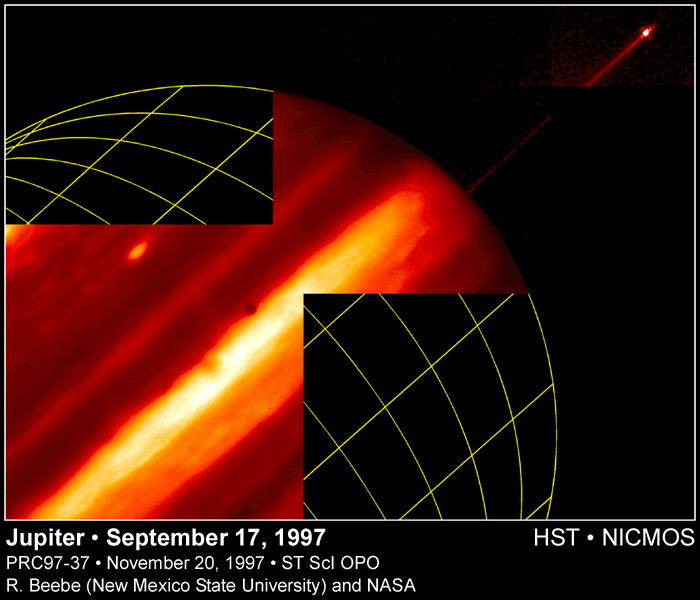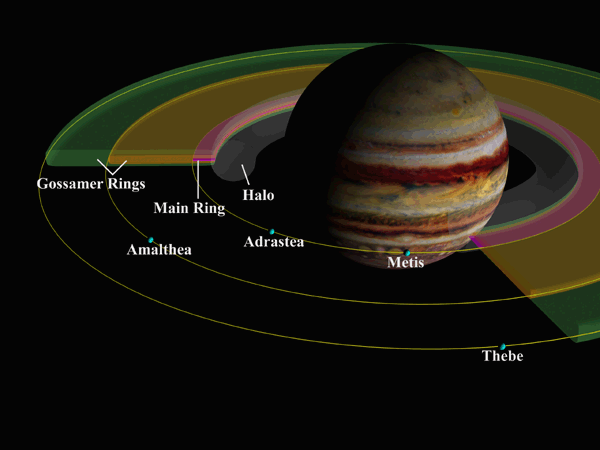

Probing Jupiter's atmosphere for the first time, the Hubble Space Telescope's new Near Infrared Camera and Multi-Object Spectrometer (NICMOS) provides a sharp glimpse of the planet's ring, moon, and high-altitude clouds.
The presence of methane in Jupiter's hydrogen- and helium- rich atmosphere has allowed NICMOS to plumb Jupiter's atmosphere, revealing bands of high-altitude clouds. Visible light observations cannot provide a clear view of these high clouds because the underlying clouds reflect so much visible light that the higher level clouds are indistinguishable from the lower layer. The methane gas between the main cloud deck and the high clouds absorbs the reflected infrared light, allowing those clouds that are above most of the atmosphere to appear bright. Scientists will use NICMOS to study the high altitude portion of Jupiter's atmosphere to study clouds at lower levels. They will then analyze those images along with visible light information to compile a clearer picture of the planet's weather. Clouds at different levels tell unique stories. On Earth, for example, ice crystal (cirrus) clouds are found at high altitudes while water (cumulus) clouds are at lower levels.
Besides showing details of the planet's high-altitude clouds, NICMOS also provides a clear view of the ring and the moon, Metis. Jupiter's ring plane, seen nearly edge-on, is visible as a faint line on the upper right portion of the NICMOS image. Metis can be seen in the ring plane (the bright circle on the ring's outer edge). The moon is 25 miles wide and about 80,000 miles from Jupiter.
Because of the near-infrared camera's narrow field of view, this image is a mosaic constructed from three individual images taken Sept. 17, 1997. The color intensity was adjusted to accentuate the high-altitude clouds. The dark circle on the disk of Jupiter (center of image) is an artifact of the imaging system.

This schematic cut-away view of the components of Jupiter's ring system shows the geometry of the rings in relation to Jupiter and to the small inner satellites, which are the source of the dust that forms the rings.
The innermost and thickest ring, shown in gray shading, is the halo that ends at the main ring. The thin, narrow main ring, shown with red shading, is bounded by the 16-kilometer-wide (10-miles) satellite Adrastea and shows a marked decrease in brightness near the orbit of Jupiter's innermost moon, Metis. It is composed of fine particles knocked off Adrastea and Metis. Although the orbits of Adrastea and Metis are about 1,000 kilometers (about 600 miles) apart, that separation is not depicted in this drawing. Impacts by small meteoroids (fragments of asteroids and comets) into these small, low- gravity satellites feed material into the rings. Thebe and Amalthea, the next two satellites in increasing distance from Jupiter, supply dust which forms the thicker, disk-like "gossamer" rings. The gossamer rings, depicted with yellow and green shading, are thicker because the source satellites orbit Jupiter on inclined paths.
These small satellites all orbit closer to Jupiter than the four largest "Galilean" satellites, Io, Europa, Ganymede and Callisto, which were discovered nearly 400 years ago. The orbital distances of the moons are drawn relative to the size of Jupiter.